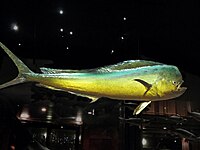
Photo from wikipedia
This journal receives a large number of articles describing fish products, particularly fish fillets, that are coated with various materials in order to prolong shelf life or improve quality. The… Click to show full abstract
This journal receives a large number of articles describing fish products, particularly fish fillets, that are coated with various materials in order to prolong shelf life or improve quality. The coating can be a thin layer of an edible material, like collagen or chitosan, with various components sometimes added to slow microbial growth, reduce oxidation, or improve flavor, etc. In some cases, plant extracts, herbal mixtures, or essential oils are applied, either alone or combined with the coating materials mentioned. The technique for making these additions is usually a simple dipping into a solution containing the wanted coating. The application of coatings is apparently popular, and the papers seem to be cited. So how can it be that many submitted articles on this topic are declined? When looking at a new submission, the first consideration concerns the novelty and the scientific merit. Unfortunately, we see that too many articles do not add very much novelty to what is already known. If a given treatment has been shown to work for a given species, there is not much novelty in showing that it also works in a species very similar to the first one. Next, the scientific merit is very often insignificant. Although the introduction explains why the study has been made, and the material and methods section explains how it has been made, the results just report that a given shelf life or a given quality has been obtained when the specified coating has been added. Such studies may be termed “cook and look,” i.e. add something, let it store (cook), and watch the result. What is needed is a clear hypothesis stating what is expected and why, based on previous knowledge, rather than merely stating that the study presented has not been done before. Next, the study should be designed such that it may be possible to explain why a given effect is being observed. It is not sufficient to make reference to other “cook and look” studies giving results more or less similar to what is observed. We need to understand why a given effect is being observed. There must be a chemical or physical mechanism explaining how e.g. microorganisms are affected, or how oxygen radicals are being quenched, if that is the result. This is a scientific merit that brings our understanding further, such that the given treatment may be applied under other circumstances where the chemical and physical conditions are known. A driving force in the use of coatings seems to be the application of so-called “natural” substances instead of synthetic chemicals to slow down microbial growth or reduce oxidation, as there is a general drive in society to “go natural.” But many of the oils and plant extracts used today are quite well characterized, so there is no need to look for a “mysterious” effect that only nature can present. On the contrary, obscure natural mixtures should be avoided, as safety regulations will not allow substances with unknown effects to be added to food. I expect future submissions to the journal on the topic of coated fish products to contain a clear novelty and have a significant scientific merit, adding meaningful knowledge to our understanding of how food quality and safety is being improved. Such submissions are welcome and will improve the impact of our journal. Other submissions will be declined.
Journal Title: Journal of Aquatic Food Product Technology
Year Published: 2017
Link to full text (if available)
Share on Social Media: Sign Up to like & get
recommendations!